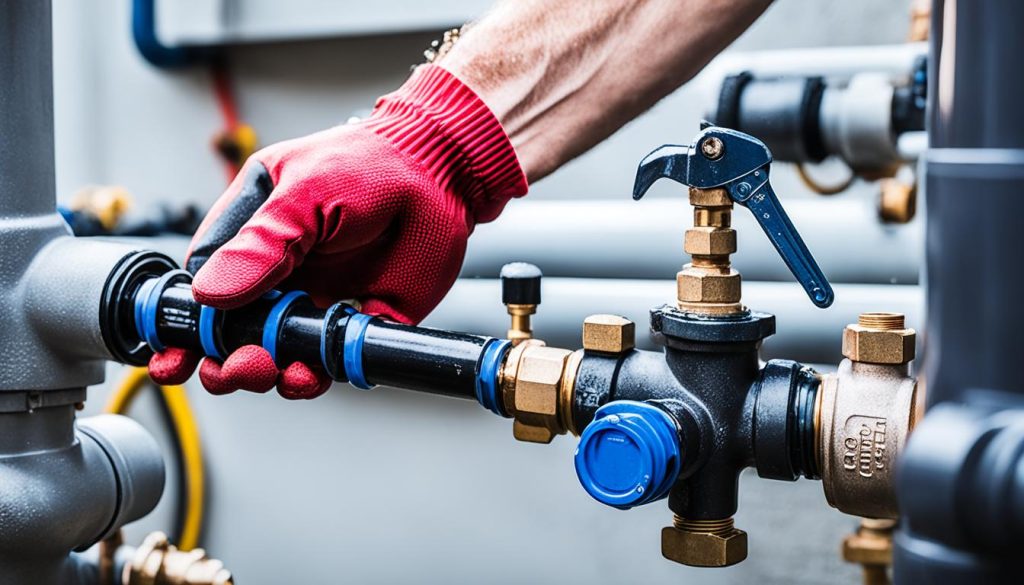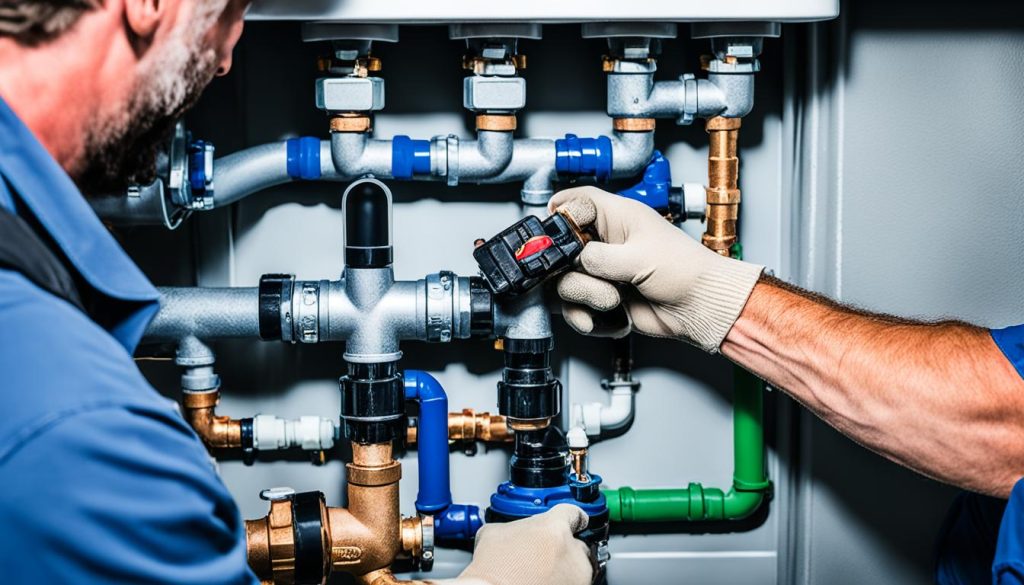Best Backflow Preventers – Secure Your Plumbing
Did you know that backflow, the reversal of contaminated water into your clean water supply, poses a serious threat to your health and safety? It’s a common problem that affects countless households across Canada. To safeguard your loved ones and ensure the integrity of your plumbing system, installing a reliable backflow preventer is crucial.
A backflow preventer is a plumbing device specifically designed to prevent the backflow of contaminated water. It acts as a barrier, ensuring that only clean water flows through your pipes, protecting you from potential health risks and preventing contamination. With the right backflow preventer, you can have peace of mind knowing that your water supply is safe and free from harmful bacteria and substances.
Key Takeaways:
- Backflow is the reversal of contaminated water into your clean water supply, posing serious health risks.
- A backflow preventer is a plumbing device that blocks the flow of contaminated water, ensuring the safety of your water supply.
- Choosing the right backflow preventer and regularly maintaining it is essential for proper functioning and effectiveness.
- Installation and repairs of backflow preventers should be done by licensed plumbers to ensure optimal performance.
- Selecting a reliable backflow preventer supplier is crucial for high-quality products and continued support.
What is Backflow and Why is it Dangerous?
Backflow is a concerning plumbing issue that poses significant risks to your health and safety. It occurs when contaminated water, filled with harmful substances and bacteria, flows backward into your clean water supply. This backflow can be triggered by changes in water pressure, such as pipe breaks or the operation of a fire hydrant.
When backflow happens, contaminants like E. Coli, salmonella, and human waste can enter your drinking water, leading to serious health hazards. Consuming contaminated water can result in illnesses and even hospitalizations. Therefore, it is crucial to take preventative measures by installing a backflow preventer in your plumbing system.
The Dangers of Backflow
- Contaminated water with bacteria and harmful substances
- Potential health risks and illnesses
- Hospitalizations
A backflow preventer serves as a safeguard, ensuring that the flow of contaminated water is stopped before it can mix with your clean water supply. It acts as a protective barrier, preventing the backflow of contaminated water and reducing the risk of health hazards.
With a backflow preventer in place, you can have peace of mind knowing that your water supply is protected from potential contamination. It is a crucial component of your plumbing system, helping to maintain the safety and quality of your drinking water.
In the next section, we will explore the different types of backflow preventers available and their applications. Understanding these options will help you make an informed decision on the most suitable backflow preventer for your specific needs.
Types of Backflow Preventers
Types of Backflow Preventers
When it comes to preventing backflow in your plumbing system, there are several types of backflow preventers to choose from. Each type has its own mechanism and application, providing different levels of protection against the reversal of contaminated water. By understanding the options available, you can select the backflow preventer that best suits your specific needs.
Air Gap Device
The air gap device is a common and effective backflow preventer that creates a physical break between the clean water source and potentially contaminated water. It consists of a vertical air gap, typically located above the flood level rim of a fixture or a storage tank. The air gap ensures that there is no direct connection between the clean water supply and the potentially contaminated water, preventing backflow from occurring.
Pressure Vacuum Breaker
A pressure vacuum breaker (PVB) is a cost-effective option for residential backflow protection. It is commonly used in sprinkler systems and residential irrigation systems. The PVB utilizes a spring-loaded valve that seals off the water supply in the event of a drop in pressure. This prevents contaminated water from flowing back into the clean water supply.
Atmospheric Vacuum Breaker
Similarly to the pressure vacuum breaker, an atmospheric vacuum breaker (AVB) is also commonly used in irrigation systems. It prevents backflow by relying on atmospheric pressure to keep the water supply protected. When the pressure in the system drops, the AVB opens, allowing air to enter the system and break the siphonage effect that causes backflow.
Double Check Valve
A double check valve is another type of backflow preventer that provides reliable protection against backflow. It consists of two check valves arranged in series, allowing water to flow in one direction while preventing it from flowing backward. This type of backflow preventer is commonly used in underground irrigation systems and fire sprinkler systems.
Reduced Pressure Zone Device
Considered the most secure and reliable backflow preventer, the reduced pressure zone (RPZ) device is designed to protect against health hazards. It provides two independent check valves with a differential pressure relief valve in between. This setup ensures that even if both check valves fail, any backflow will be discharged through the relief valve, preventing it from contaminating the clean water supply.
Choosing the right backflow preventer for your plumbing system depends on factors such as the level of protection required, specific application, and regulations in your area. Consulting with a professional plumber will help you determine the most suitable type of backflow preventer for your needs.
Importance of Backflow Preventer Testing and Maintenance
Regular testing and maintenance of backflow preventers are vital to ensure their proper functioning and effectiveness. These devices play a crucial role in preventing contaminated water from flowing back into your clean water supply. Annual testing is a necessary step to verify if the backflow preventer is working correctly and to address any potential issues that may compromise its performance.
Failure to comply with testing requirements can result in severe consequences, such as fines or even water supply cutoff. It is essential to prioritize backflow preventer testing to safeguard the health and safety of your household.
Backflow prevention devices should also undergo certification by professionals to ensure they meet safety standards. Certified devices provide an assurance of quality and reliability, giving you peace of mind that your water supply is protected.
Proper maintenance is just as important as testing. Regular maintenance checks help identify any signs of wear and tear, leaks, or other issues that may affect the performance of the backflow preventer. Timely repairs or replacements can prevent potential backflow incidents and preserve the integrity of your plumbing system.
To summarize, regular backflow preventer testing and maintenance are essential to:
- Maintain the proper functioning of the backflow preventer.
- Ensure compliance with testing requirements and avoid penalties.
- Protect the health and safety of your household by preventing backflow incidents.
- Preserve the quality and integrity of your clean water supply.
By prioritizing backflow preventer testing and maintenance, you can have confidence in the reliability of your plumbing system and the safety of your loved ones.
| Benefits of Backflow Preventer Testing and Maintenance | Consequences of Neglecting Testing and Maintenance |
|---|---|
| Ensures the backflow preventer is functioning properly | Risk of backflow incidents and contamination of clean water supply |
| Identifies and addresses any issues or malfunctions | Loss of water supply or fines for non-compliance |
| Preserves the longevity of the backflow preventer | Potential damage to plumbing system and costly repairs |
| Ensures compliance with testing regulations | Non-compliance penalties and legal consequences |
Backflow Preventer Installation and Repair
Installing a backflow preventer is a critical step in safeguarding your plumbing system, and the task requires the expertise of a trusted plumber. A professional plumber will thoroughly evaluate your plumbing system and recommend the best type of backflow preventer for your specific needs.
Proper installation is crucial for ensuring the backflow preventer functions correctly and effectively, preventing any contamination of your clean water supply. Trusting a licensed plumber with experience in backflow prevention guarantees that the installation is done according to industry standards and regulations.
If you already have a backflow preventer installed and encounter any issues or require repairs, it is essential to contact a licensed plumber specializing in backflow prevention. They have the necessary knowledge and skills to assess the problem, make the necessary repairs, and ensure that your backflow preventer is in optimal working condition.
By relying on a trusted plumber for backflow preventer installation and repair, you can have peace of mind knowing that your plumbing system is protected against the risks of backflow.
Why Trust a Professional Plumber for Backflow Preventer Installation and Repair?
Backflow preventer installation and repair are specialized tasks that should be handled by professionals in the field. Here are a few reasons why you should trust a licensed plumber for these services:
- Expertise: Plumbers with experience in backflow prevention have in-depth knowledge of different types of backflow preventers and their applications. They can recommend the most suitable option for your plumbing system.
- Compliance: Professional plumbers ensure that the installation and repairs are done in compliance with local plumbing codes and regulations.
- Efficiency: Hiring a professional ensures that the installation or repair is completed efficiently, saving you time and potential headaches.
- Warranty: Reputable plumbers often provide warranties for their installation and repair services, giving you added peace of mind.
- Ongoing Support: Licensed plumbers can offer ongoing support, including maintenance and testing, to ensure the continued effectiveness of your backflow preventer.
When it comes to backflow preventer installation and repair, relying on a trusted plumber is the best way to ensure that your plumbing system remains protected and functioning optimally.
Choose a Reliable Backflow Prevention Supplier
When it comes to selecting a supplier for your backflow prevention device, it is imperative to choose a trusted and reliable supplier that will meet your needs. As a consumer, you should prioritize suppliers that offer quality service and reliable plumbing solutions. It is important to work with suppliers who have extensive expertise in backflow prevention and possess a deep understanding of the various types of backflow preventers and their specific applications.
Additionally, ensure that the chosen supplier provides comprehensive maintenance and testing services for backflow preventers to ensure their continued effectiveness. Regular maintenance and testing are essential to identify any potential issues and to keep your backflow preventer in excellent working condition. By partnering with a reliable supplier, you can have peace of mind knowing that your backflow prevention device is of the highest quality and will effectively protect your plumbing system.
When evaluating potential suppliers, consider their track record and customer reviews. Seek out suppliers with a solid reputation for exceptional products and outstanding customer service. By choosing a trusted supplier, you can rest assured that you are investing in a backflow prevention device that will reliably safeguard your clean water supply and prioritize the health and safety of your loved ones.
Source Links
- https://www.guardianplumbinganddrain.ca/which-backflow-devices-are-the-best/
- https://www.plumbwize.ca/blog/backflow-preventers-types/
- https://amptec.ca/building-safety/backflow-preventer/
- Investing Wisely: How Windows & Doors in Boost Property Value and Financial Health - April 24, 2025
- The Financial Impact of Personal Injuries: Why Legal Help Matters for Business Owners - April 16, 2025
- The Hidden Financial Costs of Domestic Assault: What Business Owners Need to Know - April 16, 2025













